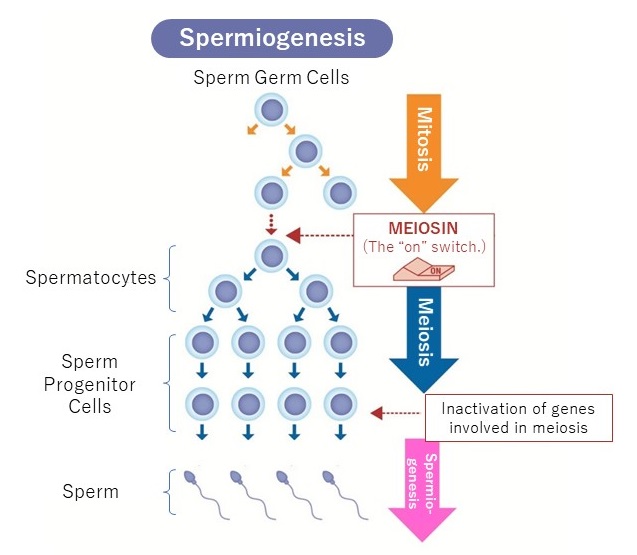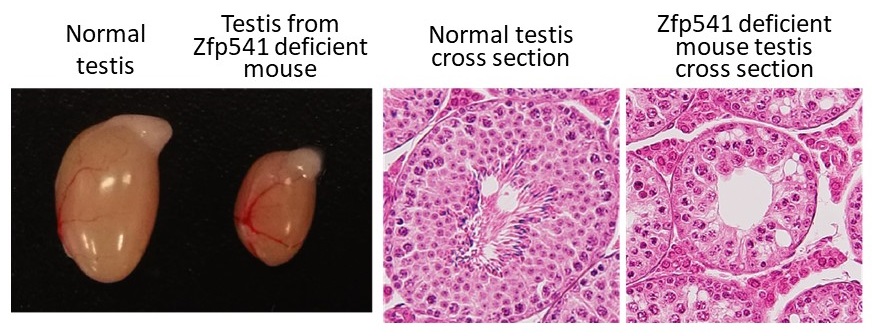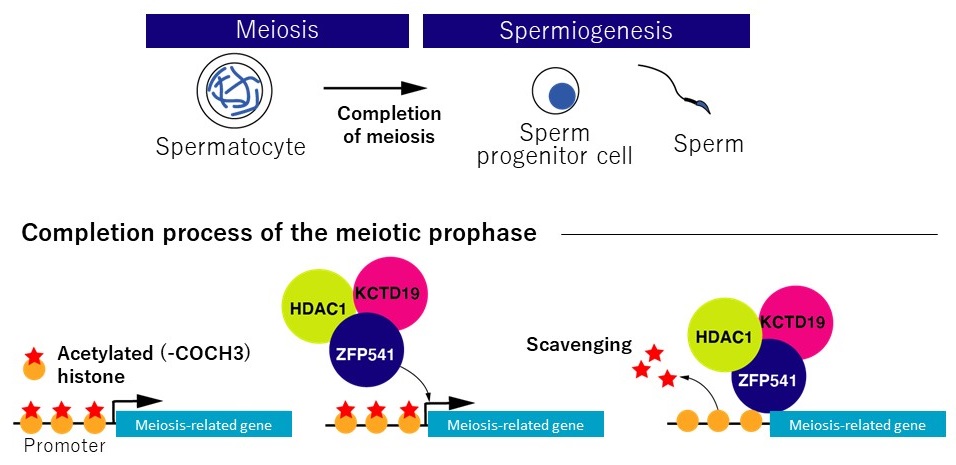A novel gene involved in male infertility: ZFP541

Understanding the mechanisms that control the expression of meiosis-related genes
A new gene that controls the completion of meiosis in spermatogenesis has been discovered by researchers from Kumamoto University. Until now, details of the mechanism that inactivates the expression of genes involved in the meiotic program during spermatogenesis had not been clarified. The researchers believe that this may lead to an advancement in reproductive medicine, like identifying causes for infertility from azoospermia or spermatogenic defects.Meiosis is the special type of cell division that takes place in the ovaries and testes to produce eggs and sperm by reducing the number chromosomes to half the original. After meiosis is complete, DNA continues to be highly condensed and undergoes major morphological changes that are characteristic of spermiogenesis. This process inactivates the expression of many genes that were previously active in carrying out meiosis in spermiogenesis. However, the details of the mechanism that completes the meiotic program at the appropriate time are unknown, and although this is an important issue that is directly related to reproductive medicine, such as male infertility, it has remained an unresolved issue many years.
Professor Ishiguro's group at Kumamoto University’s Institute of Molecular Embryology and Genetics (IMEG) previously discovered MEIOSIN, a gene that switches on meiosis and causes hundreds of genes involved in sperm and egg formation to activate simultaneously. Among them, many genes have functions that are still not fully understood. In their work to ascertain these functions, the researchers selected the ZFP541 gene to analyze in detail.
When the function of the ZFP541 gene in mice was eliminated using genome editing, male germ cells started meiosis but died in the process resulting in infertility since no sperm were produced. A detailed analysis of the testes of those mice revealed that the ZFP541 gene plays an essential role in the regulation of meiosis and is an important gene involved in sperm production.
Furthermore, ZFP541 is expressed in late meiotic prophase and binds to the regulatory regions (called promoters) of many meiosis-related genes. It is known that acetylated histones are present in the regulatory region of promoters as a marker for sustained activation of gene expression. Through mass spectrometry analysis, researchers found that ZFP541 binds to an unknown protein called KCTD19 and an enzyme called HDAC1 that has been shown by previous studies to remove acetyl groups from histones. These results show that ZFP541 and HDAC1 together eliminate the histone acetyl group, inactivate the expression of meiosis-related genes, and complete meiosis.
"This research is a follow-up to our discovery of MEIOSIN published in February of 2020 and reveals part of the function of a gene under the control of MEIOSIN whose function is still unknown," said Dr. Yuki Takada, who led the study. "Although these results were verified in mice, ZFP541 is also known to exist in humans. There are many cases of infertility in humans where the cause is unknown, but we expect that this result will contribute to the elucidation of the pathogenesis of infertility, especially those related to sperm dysplasia."
The researchers also believe that this work can be applied to the development of infertility treatment technology. By elucidating the functions of other genes in the process of egg and sperm formation, they hope to make a significant contribution to reproductive medicine.
This research was published in "Nature Communications" on 1 June 2021.
[Funding]
- Joint Usage/Research Center for Developmental Medicine, IMEG, Kumamoto University
- KAKENHI from MEXT (19K06642, 20K22638, 17H03634, 18K19304, 19H05245, 19H05743, 20H03265, 20K21504, JP16H06276),
- Takeda Science Foundation
- Joint Usage and Joint Research Programs from the Institute of Advanced Medical Sciences, Tokushima University (30-A-7)
- The Sumitomo Foundation
- The Naito Foundation
- Astellas Foundation for Research on Metabolic Disorders
- Daiichi Sankyo Foundation of Life Science
- The Uehara Memorial Foundation
- The NOVARTIS Foundation (Japan) for the Promotion of Science
[Usage Restrictions]
Image credits belong to Dr. Yuki Takada & Prof. Kei-ichiro Ishiguro unless otherwise indicated in the figure caption. To use any of the media contained within this release elsewhere, a reference to the original work (this release) should be included and other restrictions must be followed as indicated.



